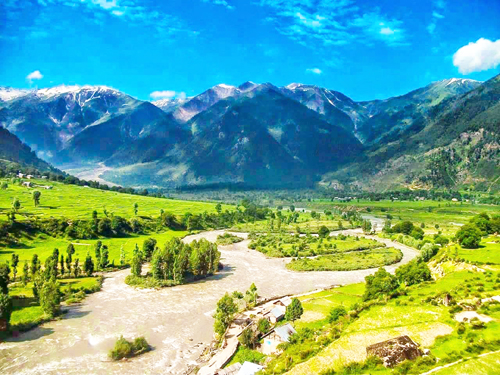Junaid Malik
Kishtwar, once a princely state a kingdom and now one of the districts of J&K state is also known as the land of saffron,sapphire and sufis due to its rich natural, geographical and religious identities bestowed upon it by the nature. Its a unique land with ubiquitous talents both in its geographical and social stratifications. There are various theories and legends to the origin of the name of Kishtwar ranging from Rajtarangni of Kalhana to that of local tell tales and folk lores. The valley surrounded by lush green forest, snow clad mountains, gushing streams and rivers and undulating meadows has been a seat of learning and leisure since centuries.
Kishtwar is a land locked valley with high mountains surrounding it. The valley of Padder bordering Himachal and Ladakh in its north west and north east is laden with sapphire, quartz and blue ruby in abundance. The valley is itself an abode of rich minerals and gushing rivers being fed to it from surrounding mountains and small valleys. The mineral wealth of this part of land is beyond imagination and not fully exploited to its core. Besides, Kishtwar with its careva and mountainous soil is a fertile land for best quality of saffron known world wide. Apart from this, the roaring and gushing river of Chenab and Marawsudar is a boon for the economy. The river water taking the second course in the run has led to the construction of dams and reservoirs which are producing electricity worth millions.
Kishtwar is also home to numerous flora peculiar to its geography like morshella, forest products, medicinal plants, herbs like hemp plant,cumin seeds locally known as zeera , incense (Dhoop)pine seed (chilgoza) and fauna like mountain beer, Himalayan musk deer,snow leopard, musk deer , wild boar and most importantly Hangul or the Kashmir stag. Kishtwar is also famous for bird species of Indian Mynah, Himalayan jungle crow,snow cock and many other species of birds and animals. Kishtwar high altitude national park was specifically designated in 1981 to save the endangered species of the area.
Kishtwar is also culturally and religiously a rich land of religious tolerance and mutual co-existence. People of all faiths and religions are living in this valley for centuries with examplery brotherhood and camaraderie. The famous Saint Shah Farid ud Din Baghdadi came to Kishtwar in 1664 and propagated Islam in Kishtwar which was carried on by his son Shah Asrar ud Din Wali. These two saints are revered by every irrespective of religion and faith which could be seen everyday and more particularly during the annual congregation.besides the Hindu temples of Sarthal Devi, Machail Devi and Gori Shanker are famous through out India.
The Buddhist people who are more concentrated in Padder also have huge Gompa there imparting education and engaged in philanthropic activities. The Sikh brethren who have mostly migrated here for the trade purpose some years back have also been accommodated by this chaste land. It is pertinent to mention here that the Tibetan refugees too are living here for more than three decades now doing trade and business without any bias and fear even during the days of armed insurgency in the state. Most of these refugees are living and doing business around the Jamia Masjid of Kishtwar. This mutual existence and harmony is a unique feature of this Sufi land.
Kishtwar is also a famous tourist and trekking land which carries this legacy for more than a century. The padder Pangi road is a world renowned biking and off roading route for adventure lovers. This road has been declared one among the ten most dangerous roads of the world. The valleys of Marwah Warwan and Padder are world famous trekking routes and many present villages like Afti Brian Saunders and many more are named after the mountaineers of Russia, America, Germany who have passed through this trek. The other unexplored heaven and pastures of Kishtwar like Bimal Nag, Sinthan, Famber, Devigol, Mughal Maidan, Mulchiter Nagishoor are hidden destination which, if explored will give a boost to local economy and boon to adventure lovers. Historically Kishtwar kingdom served as the safe heaven for fleeing kings of Kashmir Himachal and Ladakh due to its tough terrain and circuitous paths. After the Kishtwar principality was merged with Jammu and Kashmir kingdom under Maharaja Gulab Singh in 1821, his most trusted and valorous commander was appointed the Governor of Kishtwar which served his base for expedition and wars against Ladakh Tibet Himachal. It is one these wars against Tibet that Zorawar Singh got martyred in Tibet.
Socially and culturally also, Kishtwar is a very famous and fertile land to have given both the country and state a different identity icons. The famous Kashmiri singer Gh Nabi Doolwal invented a new raga known by the name of Chalanth. Besides the land has produced writers philosophers saints politicians and military valour of supreme sacrifice. Kishtwar is a hidden Paradise which is itself a victim of state apathy and political injustices. Its hidden treasures, its unmatchable beauty, natural resources and tourist destination could give a great fillip to the state as well as local economy and tourism potential. The dilapidated roads and brewing culture of communal fringe under the patronage of few parochial and anti social elements have taken a heavy toll on its pristine glory which could be restored only through a vibrant and inclusive approach of all the stake holders without any bias and favour.


